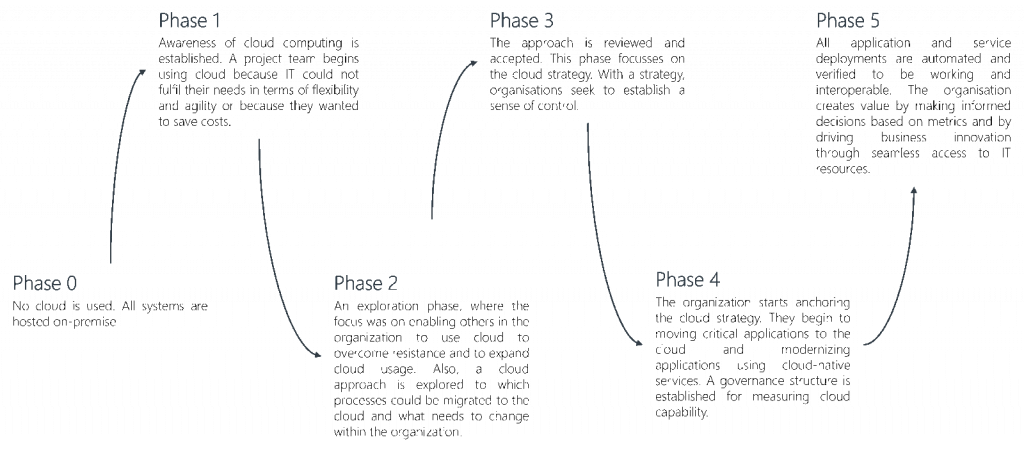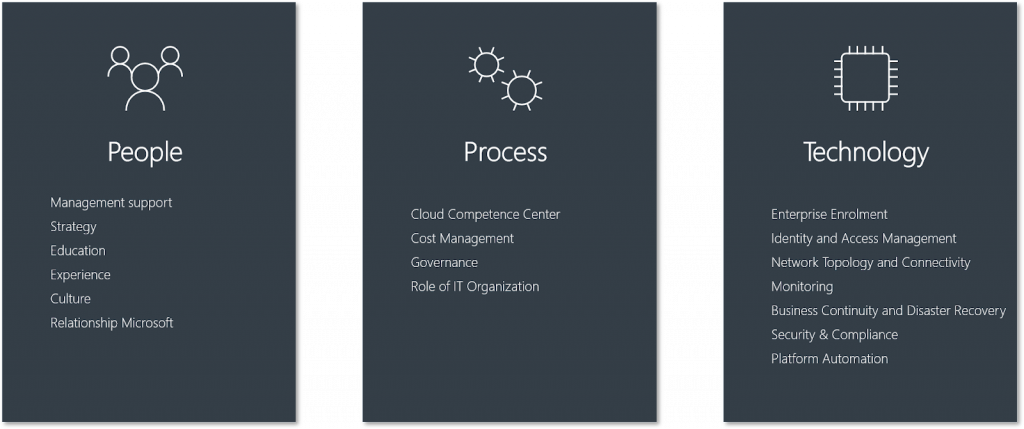Cloud computing is key to the digital transformation of many modern organizations. However, only few are able to leverage the full potential of this technology. A cloud maturity model can help assess the current stage, designing a path for organizational development, thereby simplifying the transformation towards cloud-native. However, which factors are important in this process?
INTRODUCTION
An increasing number of organizations feel the need to change in order to meet customer demands while remaining competitive[1]. To complete this change, organizations need to digitally transform and start asking questions such as ‘How can we improve our cloud adoption?’ and ‘What is the best next step?’. They often lack guidance during their transformation process[2]. Therefore, few companies are in the position to leverage the benefits of digital technology[1].
Cloud computing plays a key role in the digital transformation process of many organizations as shown by the incredible growths of the cloud computing market[3]. Gartner quantifies this transformation by stating that the cloud-computing market will grow by 17% between 2019 and 2020. Currently, cloud computing has a limited number of best practices and guidelines that can support organizations in their digital transformation. Due to the rapidly changing environment along with the slow pace of cloud adoption amongst companies, only few companies benefit from the cloud’s full potential[4].
CLOUD COMPUTING
Organisations seek to reap the benefits that cloud has to offer, such as scalability, reliability and cost effectiveness. It offers the ability to turn services on when they are needed, making it easier for organisations to scale up when more capacity is needed without increasing capital expenditure[5]. However, IT providers often misuse the term cloud computing for marketing purposes[6]. For instance, vendors may use the term ‘cloud’ when talking about their own data centres. This ‘private cloud’ does not include the scalability, flexibility and agility combined with cost savings. Cloud computing promises to deliver the full functionality of existing IT services while reducing the upfront costs of computing[5].
Having mentioned this, what is public cloud exactly? According to the National Institute of Standards and Technology (NIST) [7] (Mell et al.) cloud computing is defined as “A model for enabling ubiquitous, convenient, on-demand network access to a shared pool of configurable computing resources (e.g. networks, servers, storage, applications, and services) that can be rapidly provisioned and released with minimal management effort or service provider interaction”.
CLOUD MATURITY
Without guidance, it is difficult to fully transform to a cloud-native organization. By assessing its cloud maturity and creating a path for organizational development, the transformation towards cloud-native can be simplified[8]. Maturity is defined as the state of being complete, perfect or ready[9]. A cloud maturity model consists of different phases that mature along a predefined path. One of the available cloud maturity models is the Cloud Maturity Model (CMM) of the Open Alliance for Cloud Adoption. The model can be used to determine the maturity level of an organization or for organizational enhancement[10]. Based on interviews with both IT professionals and Subject Matter Experts, and maturity descriptions of the CMM, the cloud maturity phases are described as follows:

CLOUD MATURITY FACTORSThe phases described above entail a very general description. As can be imagined, the cloud maturity of an organization differs across People, Processes and Technology. Each category can be split into different factors which influence the cloud adoption process[11]. Based upon academic literature and interviews with subject matter experts, 16 overarching factors are defined that influence an organization’s cloud maturity. Interviewees were asked to describe their organization’s cloud journey and emphasize what was important. For example, one interviewee explained that it is important that a strategy is developed by management, and management should also share their strategy with the employees. This has been consolidated as management support. All described factors are visualized in the figure below.

CONCLUSION
This all being said, it should be remembered that cloud adoption is a journey. But now and then, it is important to understand where you are in that journey, where one would like to be and which steps are needed to get there. A cloud maturity model helps to assess the current situation and help identify the phases needed to achieve the desired end state. Adding the cloud maturity factors provides an extra focus point. In this way, we are aware of that which is already mature enough and where some added attention is needed.
REFERENCES
- Westerman, G., Calméjane, C., Bonnet, D., Ferraris, P., & McAfee, A. (2011). Digital Transformation: A roadmap for billion-dollar organisations. MIT Center for Digital Business and Capgemini Consulting, 1, 1-68.
- Westerman, G., Tannou, M., Bonnet, D., Ferraris, P., & McAfee, A. (2012). The Digital Advantage: How digital leaders outperform their peers in every industry. MITSloan Management and Capgemini Consulting, MA, 2, 2-23.
- Berman, S. J., Kesterson‐Townes, L., Marshall, A., & Srivathsa, R. (2012). How cloud computing enables process and business model innovation. Strategy & Leadership.
- Nasir, U., & Niazi, M. (2011). Cloud computing adoption assessment model (CAAM). In Proceedings of the 12th International Conference on Product Focused Software Development and Process Improvement (pp. 34-37). ACM.
- Avram, M. G. (2014). Advantages and challenges of adopting cloud computing from an enterprise perspective. Procedia Technology, 12, 529-534.
- Hoberg, P., Wollersheim, J., & Krcmar, H. (2012). The business perspective on cloud computing-a literature review of research on cloud computing.
- Mell, P., & Grance, T. (2009). Draft NIST working definition of cloud computing. National Institute of Standards and Technology. Information Technology Laboratory.
- Lahrmann, G., Marx, F., Winter, R., & Wortmann, F. (2011, January). Business intelligence maturity: Development and evaluation of a theoretical model. In 2011 44th Hawaii International Conference on System Sciences (pp. 1-10). IEEE.]
- Oxford, O. E. (2009). Oxford English Dictionary. Oxford: Oxford University Press.
- Paulk, M. C., Curtis, B., Chrissis, M. B., & Weber, C. V. (1993). Capability maturity model, version 1.1. IEEE software, 10(4), 18-27.
- Low, C., Chen, Y., & Wu, M. (2011). Understanding the determinants of cloud computing adoption. Industrial management & data systems, 111(7), 1006-1023.



